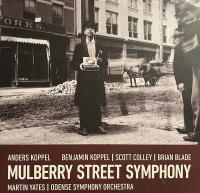I like what I’m hearing but I can only find the CD
Anders Koppel's Mulberry Street Symphony Is Made For These Times
Suburban Baby Boomer adolescents may have heard the stories from their immigrant parents and grandparents but reading the book and seeing the photos put the experience in sharp focus. “How the Other Half Lives” was required reading in many high schools and colleges throughout the ‘50s and ‘60s and today may very well still be.
75 year old Danish composer Anders Koppel—himself descended from immigrant grandparents who fled in 1907 to Denmark from Russian controlled Poland—was moved by a recent exhibition of Riis photographs in Copenhagen to compose the 7 movement, 90 minute long “Mulberry Street Symphony”, his 32nd symphonic work for soloists and orchestra, each movement based on a different Riis photograph (Mr. Koppel’s name will be familiar to fans of the late ‘60s era psychedelic rock group The Savage Rose).
Koppel composed and orchestrated the sprawling, cinematic piece but left wide open for improvisation the trio’s input. With a rhythm section consisting of his American friends jazz greats drummer Brian Blade and bassist Scott Colley plus his son Benjamin on alto saxophone, why not? Plus, according to the composer’s notes Colley and his friend Ben originally hatched the idea.
Could there be a more appropriate time than right now for a cinematic musical work reflecting the hardships, dreams, grace and especially the courage of immigrants?
Composer Koppel uses the old, still evocative photos to paint evocative musical pictures in swirling soundscapes produced by the Odense Symphony Orchestra’s strings over which the trio improvises, adding narrative structure and rhythmic solidity to the orchestral moodscapes.
The composers son on alto sax carries and punctuates the narrative thread, often producing a light, airy clarinet-like “eastern European” sound as it flutters and sways over the enveloping orchestral cushion.
The 7 pieces in the order in which they are played are “Stranded in the Strange City”, “Minding the Baby”, “Tommy the Shoeshine Boy”, “Blind Man”, “The Last Mulberry”, “Bandit’s Roost” and “The New House”.
The highly evocative music is fleeting, impressionistic, not locked to melody and it never stands still. “Stranded in the Strange City” is meant to (and does) create an overwhelming rush of sensations—awe, confusion, terror, relief— that must have been felt by the “just off the boat” immigrants. If “Stranded in the City” is at first too much, consider starting on side “C” with “Blind Man” (the cover image of the man selling pencils) and “The Last Mulberry” (a bluesy elegy to a failing tree, finally cut down).
Each play of this “lights out is best” production amplifies the improvisational genius of the trio as it alternates between echoing and clearing a musical path for meticulously scripted orchestral underpinnings written by the older Koppel and performed by the Odense Symphony conducted by the composer’s long time collaborator Martin Yates. The recording occurred the day following a live performance so everyone was well-prepared.
This project would not work as a recorded piece worthy of repeated listening were it not superbly recorded. The sound, recorded at Carl Nielsen Hall, Odense Concert House October 13th, 2017 is IMAX or Cinerama great.
The performance was captured to DXD audio (Digital eXtreme Definition), 352.8kHz/32 bit on a Pyramid DAW system with Horus preamps/converters and monitored on B&W 802D speakers. Of equal if not greater importance is the microphone configuration used to record the orchestra: a main “Decca Tree” using 3 Danish DPA 4006 microphones plus a pair of DPA “spot mics” for the hall. The younger Koppel’s saxophone was recorded with a Neumann U89 and a DPA 4011, while a U89 picked up Colley’s bass. Blade’s drum kit was mic’d with a pair of AKG414s and DPA 4011 and 4006 microphones.
As you might imagine, the sonic picture is grand, sweeping, cinematically splendiferous, dynamic, spacious and transportive. The Nordsø Records pressing was silent, flat and concentric.
Two small complaints: according to the liner notes there was a “bonus track” that must only be on a digital disc, of a “foyer performance” with the trio joined by the composer on Hammond organ recorded following one of the live concerts. It would have been nice to have it on a bonus 45! The other small quibble is it reads as if Bill Milkowski’s annotation got mangled in a few spots in the English-Danish-English editing and translation process. No big deal though. A bigger deal is that I’m not sure where the double vinyl gatefold set is available for purchase, but it’s well worth looking for and buying. It’s a piece of music made for these times.
You can find the composer’s description here.
And while I'm at it, you might enjoy this letter published in The New York Times written by my late uncle Max, an immigrant who was involved in New York's Tenement Museum.
- Log in or register to post comments


You can buy the LP at Cowbell Music Shop:
https://www.cowbellmusic.dk/shop/
Greetings from Copenhagen
Mathilde
Cowbell Music

Is the lp available anywhere in the USA? It doesn't seem that the link to cowbellmusic allows for shipping outside of Denmark

to order to anywhere outside DK. Do you plan to change this or was you post just meant for Danish folks here?
Not sure if Michael really recommended a record which is only available at one shop for Danish vinyl fans.

It’s strange, Cowbell advertise a vinyl release they have no solution yet to distribute anywhere (even in DK) except by their own label inside DK. It’s not even available on imusic.dk
So far, this article is for the danish analogplanet readers only ;-)

Koppel did a wonderful Siegfried back in the 60s.

I bought this record from the Cowbell site since the day this review was published. I live in Mexico and I already received it. I had no problem buying it from the Cowbell site. I join the MF review - great release!




